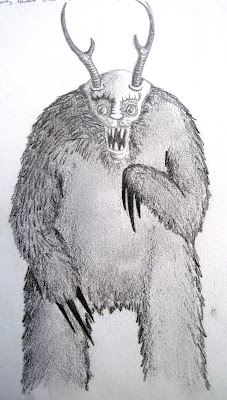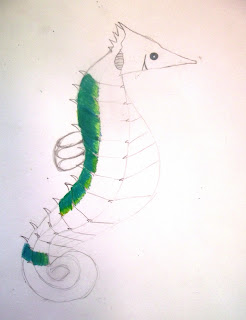The explorers guide to drawing fantasy creatures by Emily Fiegenschuh.

First of all I need to begin by stating what a beautifully presented hardback book this is. It is the first time I have seen an art instruction book in hardback form. The colour and presentation of the artwork is very eye catching.
The book is set out in what seems to be the standard way for art instruction books but in a refreshing change it only dedicates a double page to workspace and tools and then jumps straight in to drawing.
The drawing section takes you through a few features on things like constructing your creatures, human bodies and proportion, perspective, foreshortening pencil rendering techniques and using colour. All of these are very useful but one I found particularly inspiring was a section on using gesture lines to create more dynamic poses.
The author goes into great detail about using reference for your art, something that I cannot get across to my students enough. The use of real world reference is mentioned throughout the book, reinforcing its importance in creating realistic fantasy creatures.
A feature of the book that I like are the “pop up” tips that appear throughout. These give an artist’s insight into solving a particular problem. I always find it very useful to get tips like these from artists as they have spent many years honing their skills and these sort of tips can prove invaluable to an aspiring artist.
The bulk of the book focuses on designing mythical creatures. Each creature gets a few pages dedicated to it, demonstrating how to draw the creature from bare bones to finished piece. There are also in depth guides on specific elements of each creature, for instance, on the “Draw a Minotaur” demo it goes into detail over two pages of how to draw monster hands. All the demonstrations are easy to follow, beginning with gesture lines and building blocks to create the rough shape with subsequent steps fleshing out the creatures until you are left with a complete piece. There are over 20 of these demonstrations split up into sections depending on their habitat. There is only one step by step painting demo, a lantern bat, and I would have liked there to be more of these as she is one of the few artists who specialises in gouache paint. Maybe this will be the direction a future book of hers goes in?
Despite this, I really enjoyed the book and found the demonstrations easy to follow and informative. Out of the many art instruction books I have read I must say it was very refreshing to have one that was more concerned with teaching good art techniques rather than be a showcase for the artists work.

















